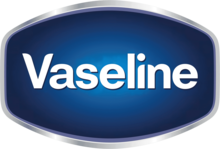Vaseline(/ˈvæsəliːn/)[1][2][note 1]is an American brand ofpetroleum jelly-based products owned by British multinational companyUnilever.[3]Products include plain petroleum jelly and a selection of skin creams,soaps,lotions,cleansers, anddeodorants.
 | |
| Product type | Petroleum jelly,body lotion |
|---|---|
| Owner | Unilever |
| Country | United States |
| Introduced | 1872 |
| Markets | Worldwide |
| Tagline | The Healing Power of Vaseline |
| Website | vaseline |
In many languages, the word "vaseline" is used asgenericfor petroleum jelly; inPortugal,the Unilever products are called Vasenol.
History
editIn 1859,Robert Chesebrough,a chemist who formerly clarifiedlamp oilfromsperm oil,a waxy oil from the heads ofsperm whales,was losing business as whale oil was replaced bycoal oil.He traveled to the oil fields inTitusville, Pennsylvaniato research what new materials might be created from this new fuel. There he learned of a residue called rod wax that had to be periodically removed from oil rig pumps. The oil workers had been using the substance to heal cuts and burns. Chesebrough took samples of the rod wax back toBrooklyn,extracted the usable petroleum jelly, and began manufacturing a medicinal product he called Vaseline.[4]
The first known reference to the name Vaseline was by theChesebrough Manufacturing Companyin the U.S. patent (U.S. Patent 127,568) in 1872. "I, Robert Chesebrough, have invented a new and useful product from petroleum which I have named Vaseline..."
The name "vaseline" is said by the manufacturer to be derived fromGermanWasser"water" +Greekέλαιον (elaion) "oil".[5]
Vaseline was made by the Chesebrough Manufacturing Company until the company, which merged withPond'sin 1955, was purchased byUnileverin 1987.[3]
Uses
editVaseline can be used as a lubricant for metallic and plastic surfaces. It can also be used as a moisture insulator for local skin conditions characterized by dry skin, such asatopic dermatitisandeczema.[6]Vaseline should not be used as asexual lubricant,as it may introduce infection-causing bacteria,[7][8][9]damage latex condoms,[10][11]and is not recommended for internal use.[12]
Topical application
editAs apetrolatumproduct, Vaseline is used as atopicalmoisturizerwhich assists with skin water retention by acting as an occlusive agent that preventsevaporationof water from thestratum corneum(outermost skin layer) and seals out external water.[12][6]Vaseline is intended for external use only, and is not recommended for deep skin cuts or punctures, animal bites, or serious burns.[6]Topical petrolatum products like Vaseline are used to manage and relieveatopic dermatitisandeczemain adults.[12][13]
Vaseline containsmineral oils.[6]Unrefined mineral oils often contain adulterants includingpolycyclic aromatic hydrocarbons(PAHs), which can increase risk for certain forms of cancer when consumed orally.[14]When used topically (as is recommended with Vaseline), dermal absorption of PAHs is insignificant.[15]No link between topical petroleum jelly-based moisturizers and cancer has been found in large studies over many years.[16]
Ingredient sources
editWhite petrolatum,the ingredient in petroleum jelly Vaseline, is refined frompetroleum.
References
editNotes
edit- ^Also pronounced with the main stress on the last syllable/ˌvæsəˈliːn/.
Citations
edit- ^"Definition of Vaseline".The Free Dictionary.RetrievedNovember 7,2013.
- ^"Define Vaseline".Dictionary.com.RetrievedNovember 7,2013.
- ^abSpeser, Phyllis L. (2012).The Art and Science of Technology Transfer.John Wiley & Sons. p. 210.ISBN978-1-118-42893-1.
- ^The History of Vaseline Petroleum Jelly began in the Pennsylvania Oil Fields!, Drake Well Museum pamphlet, copyright 1996 by Holigan Group Ltd, Dallas, Texas
- ^Webster's Unabridged Dictionary(1913)
- ^abcd"Petrolatum topical".Drugs.com. February 23, 2021.RetrievedNovember 4,2022.
- ^Brown, Joelle M.; Poirot, Eugenie; Hess, Kristen L.; Brown, Stephen; Vertucci, Michele; Hezareh, Marjan (March 11, 2016)."Motivations for Intravaginal Product Use among a Cohort of Women in Los Angeles".PLOS ONE.11(3): e0151378.Bibcode:2016PLoSO..1151378B.doi:10.1371/journal.pone.0151378.PMC4788422.PMID26967165.
- ^Brown, Joelle M.; Hess, Kristen L.; Brown, Stephen; Murphy, Colleen; Waldman, Ava Lena; Hezareh, Marjan (April 2013)."Intravaginal Practices and Risk of Bacterial Vaginosis and Candidiasis Infection Among a Cohort of Women in the United States".Obstetrics & Gynecology.121(4):773–780.doi:10.1097/AOG.0b013e31828786f8.PMID23635677.S2CID1580695.
- ^Workowski, Kimberly A.; Bachmann, Laura H.; Chan, Philip A.; Johnston, Christine M.; Muzny, Christina A.; Park, Ina; Reno, Hilary; Zenilman, Jonathan M.; Bolan, Gail A. (July 23, 2021)."Sexually Transmitted Infections Treatment Guidelines, 2021".MMWR. Recommendations and Reports.70(4):1–187.doi:10.15585/mmwr.rr7004a1.eISSN1545-8601.ISSN1057-5987.PMC8344968.PMID34292926.
- ^Voeller, Bruce; Coulson, Anne H.; Bernstein, Gerald S.; Nakamura, Robert M. (January 1989). "Mineral oil lubricants cause rapid deterioration of latex condoms".Contraception.39(1):95–102.doi:10.1016/0010-7824(89)90018-8.PMID2535978.
- ^de Graaf, Ron; Vanwesenbeeck, Ine; van Zessen, Gertjan; Straver, Cees J.; Visser, Jan H. (February 1993). "The effectiveness of condom use in heterosexual prostitution in The Netherlands".AIDS.7(2):265–270.doi:10.1097/00002030-199302000-00016.PMID8466690.S2CID25489307.
- ^abcEichenfield, Lawrence F.; Tom, Wynnis L.; Berger, Timothy G.; et al. (2014)."Guidelines of care for the management of atopic dermatitis".Journal of the American Academy of Dermatology.71(1):116–132.doi:10.1016/j.jaad.2014.03.023.ISSN0190-9622.PMC4326095.PMID24813302.
- ^van Zuuren, Esther J; Fedorowicz, Zbys; Lavrijsen, Adriana; Christensen, Robin; Arents, Bernd (March 11, 2016). Van Zuuren, Esther J (ed.)."Emollients and moisturisers for eczema".Cochrane Database Syst Rev.2(2): CD012119.doi:10.1002/14651858.cd012119.PMC6464068.PMID28166390.
- ^IARC Working Group, on the Evaluation of Carcinogenic Risks to Humans (2012)."MINERAL OILS, UNTREATED OR MILDLY TREATED".Chemical Agents and Related Occupations.International Agency for Research on Cancer.RetrievedNovember 4,2022.
- ^Chuberre, B.; Araviiskaia, E.; Bieber, T.; Barbaud, A. (October 7, 2019)."Mineral oils and waxes in cosmetics: an overview mainly based on the current European regulations and the safety profile of these compounds".Journal of the European Academy of Dermatology and Venereology.33(S7):5–14.doi:10.1111/jdv.15946.eISSN1468-3083.ISSN0926-9959.PMID31588613.S2CID203850745.
- ^Pirow, Ralph; Blume, Annegret; Hellwig, Nicole; Herzler, Matthias; Huhse, Bettina; Hutzler, Christoph; Pfaff, Karla; Thierse, Hermann-Josef; Tralau, Tewes; Vieth, Bärbel; Luch, Andreas (October 21, 2019)."Mineral oil in food, cosmetic products, and in products regulated by other legislations".Critical Reviews in Toxicology.49(9):742–789.doi:10.1080/10408444.2019.1694862.eISSN1547-6898.ISSN1040-8444.PMID31939687.S2CID210812934.